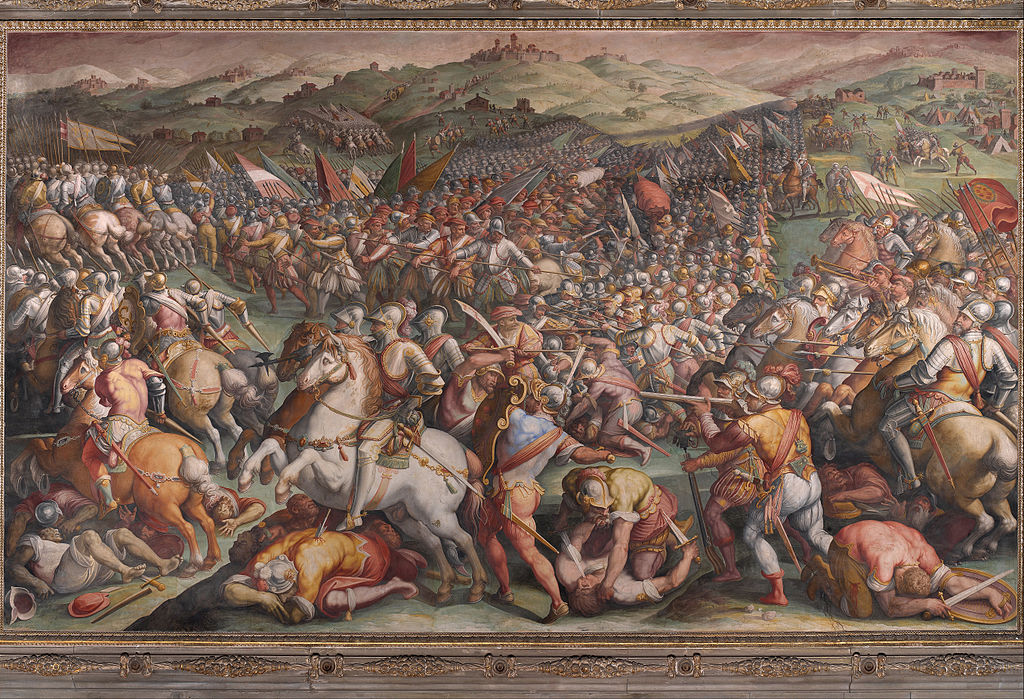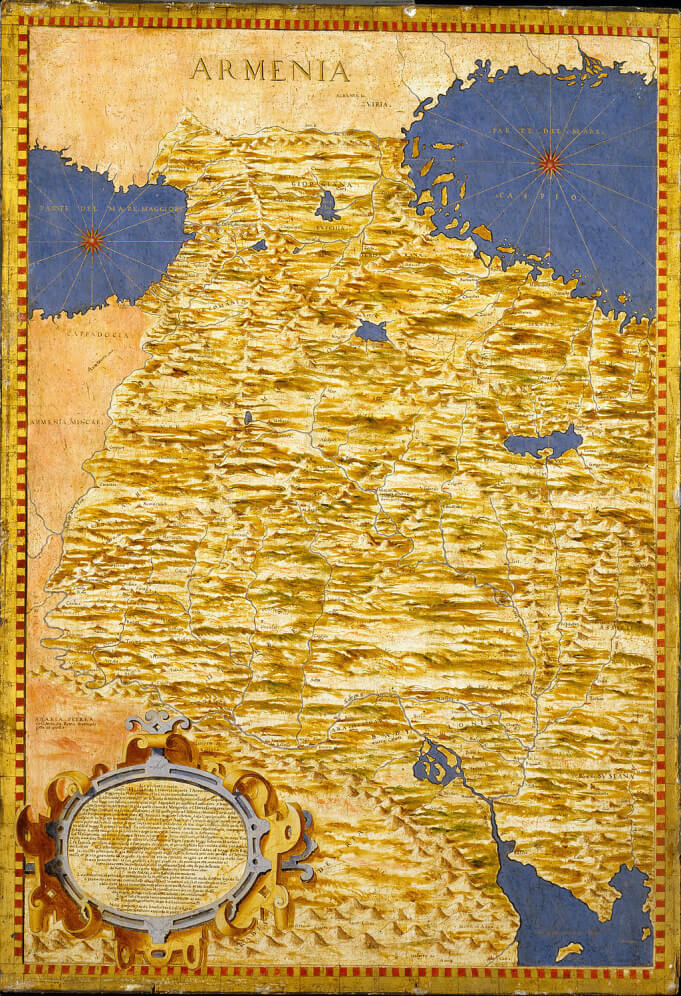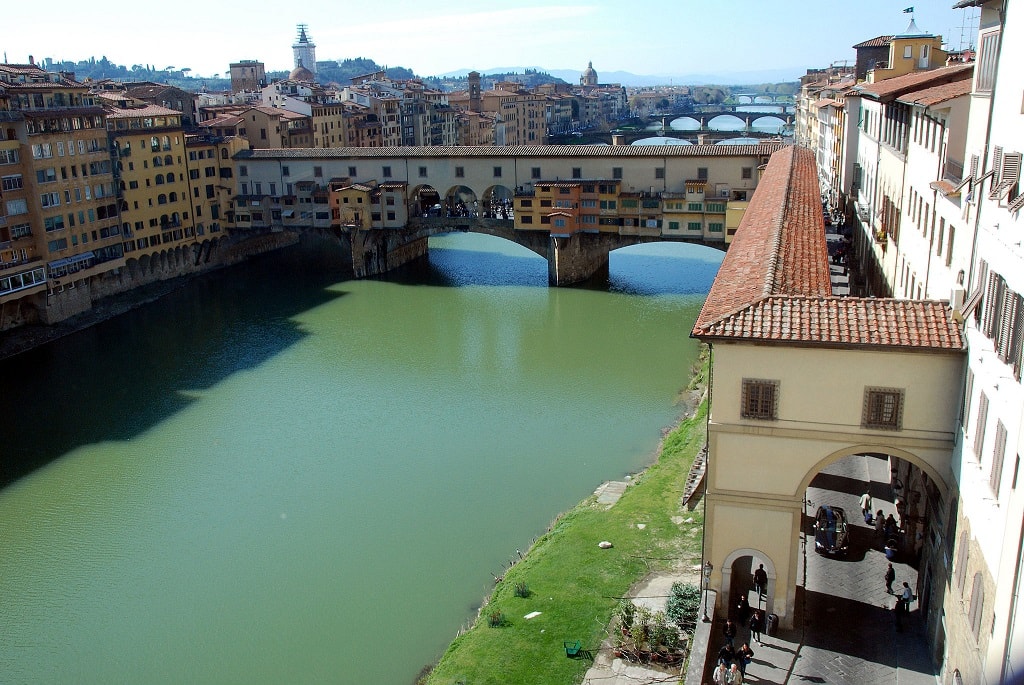|
Where? Hall of the Five Hundred in the Palazzo Vecchio
When? 1565 Commissioned by? Duke Cosimo I de’ Medici What do you see? The battle of Marciano is a bloody battle between the Republic of Siena and Florence, which was won by the Florentine. In the foreground, several explicit scenes are depicted of people getting killed in man-to-man battles. The rest of the fresco shows the battle between the large armies of Florence and Siena. Backstory: This fresco is also known as the Battle of Scannogallo (which was a creek near the village of Marciano della Chiana). The fresco marks the victory of the Florentine army over the army of Siena. The Florentine army worked together with the Spanish army, while the Republic of Siena got help from the French army. Both sides had a total of about 15 thousand soldiers that day. While on the Florentine side only 200 people got killed, the Siena side suffered losses of 4,000 with an additional 4,000 people captured. Why the Battle of Marciano? The battle of Scannagallo took place on August 2, 1554. It was a battle between the Florentine army under the command of Gian Giacomo Medici (following orders of Duke Cosimo I de’ Medici) and the Siena army under the command of Piero Strozzi. The goal of Duke Cosimo I de Medici was to get complete control of Tuscany, and for that, the Republic of Siena had to be conquered. This battle was a very important event in the decline of the Republic of Siena, and in 1559 they finally surrendered to Florence. Who is Vasari? Giorgio Vasari (1511-1574) was an architect, historian, painter, and writer. The paintings in the Hall of the Five Hundred are considered to be one of his best paintings. He was also the creator of the Hall of Geographical Maps which is also in the Palazzo Vecchio. Vasari was also a very successful architect and his work includes the construction of the Uffizi Museum and the Vasari Corridor in Florence. However, he is most famous nowadays for his book e Vite de’ più eccellenti pittori, scultori, e architettori da Cimabue insino a’ tempi nostril, translated as Lives of the Most Excellent Painters, Sculptors, and Architects, from Cimabue to Our Times, which documents the history of the Italian Renaissance (Amazon link to the book).
Dan Brown: This painting plays an important role in the book Inferno by Dan Brown (Amazon link to the book). On a green flag in the top middle of the fresco the words ‘cerca trova’ are written, which means ‘seek and ye shall find’. Without binoculars, it is almost impossible to see this.
The green flags belonged to the Siena army and they used to include different verses of Dante on them for inspiration. Duke Cosimo I wanted the sentence ‘cerca trova’ to be included in the painting as an ironic reference to the ‘defeat’ that the Siena army found. In Dan Brown’s book Inferno the words ‘cerca trova’ play an important role and lead the main character Robert Langdon to the death mask of Dante. What is a Fresco? A fresco is a painting that is executed using the fresco technique. This technique paints directly on wet lime plaster (a mix of sand, water, and lime that becomes solid when it dries). After the pigment is applied to the wet plaster and the plaster dries, the painting becomes an integral part of the wall. A mural is a more general word than a fresco as murals can also be created using different techniques. Fun fact: It has long been believed by many that below the fresco of Vasari a famous fresco of Leonardo da Vinci can be found. In 1505 Leonardo da Vinci completed a fresco called The Battle of Anghiari. This fresco is referred to as the ‘lost Leonardo’ and preparatory sketches from Leonardo for this fresco and copies by later artists, such as Peter Paul Rubens, serve as evidence for the existence of this fresco. There are three reasons to believe that the lost Leonardo may indeed still be hidden here.
Interested in a copy for yourself? Poster or Canvas
1 Comment
Marco
4/23/2016 06:20:10 am
The writing CERCA TROVA is really an encrypted message.
Reply
Leave a Reply. |
Categories
All
|
- Home
- Blog
-
Museums
- Alte Pinakothek
- Art Institute of Chicago
- Baltimore Museum of Art
- Barber Institute of Fine Arts
- Bargello
- Barnes Foundation
- British Museum
- Church of Sant’Anastasia
- Cleveland Museum of Art
- Courtauld Institute of Art
- Detroit Institute of Arts
- Frans Hals Museum
- Galleria Borghese
- Gallerie dell'Accademia
- Getty Museum
- Guggenheim
- Hermitage Museum
- Kunsthistorisches Museum
- Kunstmuseum Basel
- Legion of Honor Museum
- Louvre
- Mauritshuis
- Metropolitan Museum of Art
- Musee d’Orsay
- Museum of Fine Arts in Boston
- Museum of Modern Art
- National Gallery in London
- National Gallery of Art
- National Museum in Poznań
- Norton Simon Museum
- Ny Carlsberg Glyptotek
- Palace of Versailles
- Palazzo Pitti
- Palazzo Vecchio
- Petit Palais
- Philadelphia Museum of Art
- Prado
- Pushkin Museum
- Ravenna Art Museum
- Rijksmuseum
- San Diego Museum of Art
- Santa Maria delle Grazie
- St. Peter's Basilica
- Städel Museum
- Statens Museum for Kunst
- Tate Britain
- Tate Modern
- Timken Museum of Art
- Uffizi
- Vatican Museums
- Wallace Collection
-
Artists
- Altdorfer
- Anguissola
- Berlin Painter
- Bosch
- Botticelli
- Boucher
- Bronzino
- Bruegel the Elder
- Brunelleschi
- Cabanel
- Caillebotte
- Canova
- Caravaggio
- Carpeaux
- Cezanne
- Cimabue
- David
- Degas
- Delacroix
- De Maria
- Donatello
- El Greco
- Fontana
- Fra Angelico
- Fragonard
- Gauguin
- Gentileschi
- Gericault
- Gonzalez-Torres
- Goya
- Hals
- Hogarth
- Hokusai
- Ingres
- Leonardo da Vinci
- Lippi, Filippo
- Longhi, Barbara
- Lorrain
- Makovsky
- Manet
- Massys
- Matisse
- Merian
- Michelangelo
- Mochi
- Modigliani
- Monet
- Panini
- Parmigianino
- Perugino
- Picasso
- Pisanello
- Raphael
- Rembrandt
- Renoir
- Reynolds
- Rivera
- Rodin
- Rubens
- Scultori
- Seurat
- Steen
- Tintoretto
- Titian
- Toulouse-Lautrec
- Turner
- Uccello
- Van der Weyden
- Van Dyck
- Van Eyck
- Van Gogh
- Van Hemessen
- Vasari
- Velazquez
- Vermeer
- Veronese
- Vigée Le Brun
-
Locations
- Books
- About Us




